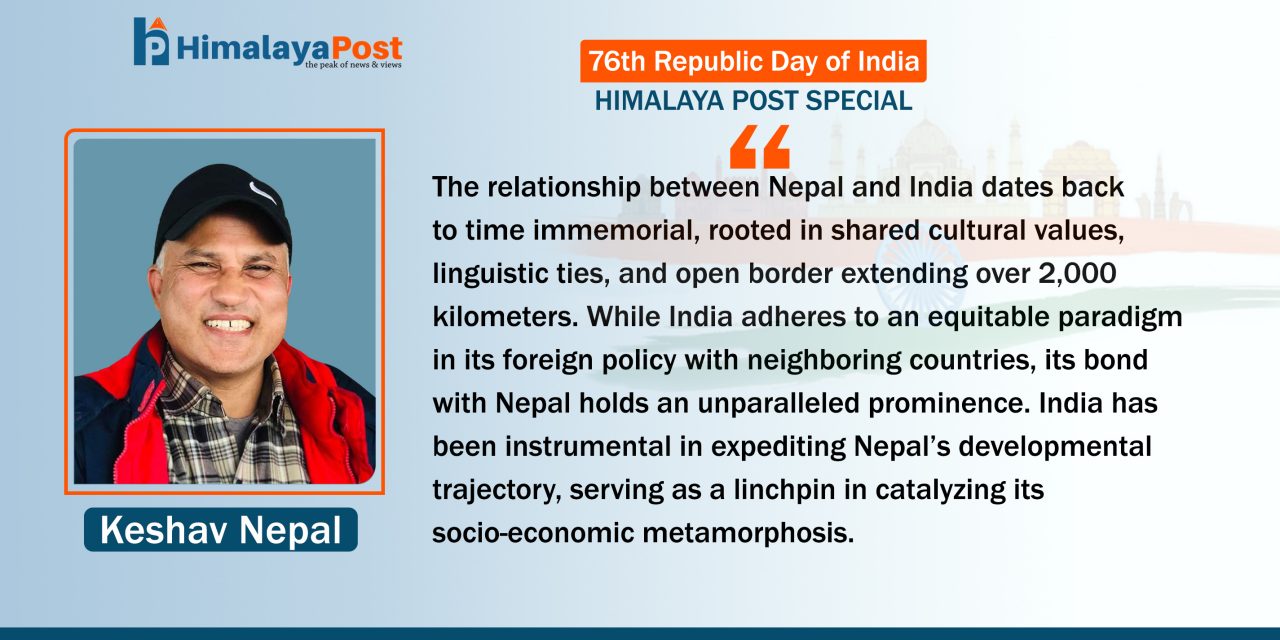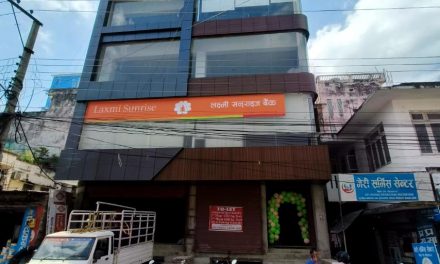– Keshav Nepal
In the realm of international relations, geographical proximity often shapes the nature of interactions between countries. For nations that share borders, particularly in regions with diverse socio-economic landscapes, the development of neighboring countries becomes crucial. The balance of growth and development plays a pivotal role in maintaining peace, prosperity, and the overall well-being of the people within these nations. This is especially true for India and Nepal, two countries bound not only by geographical proximity but also by shared cultural, historical, and economic ties.
India: A Trusted Development Partner of Nepal
India and Nepal share a deep-rooted relationship shaped by history, geography, and cultural affinities. Over the years, India has established itself as a resolute development partner for Nepal, playing a pivotal role in advancing its socio-economic progress. Through a wide array of initiatives encompassing education, healthcare, infrastructure, energy, culture, and disaster management, India has consistently reaffirmed its unwavering commitment to Nepal’s growth and prosperity.
This enduring partnership transcends mere transactions; it is a testament to the trust, mutual respect, and shared vision for regional progress. The development projects completed in 2024 stand as compelling evidence of India’s dedication to fostering Nepal’s sustainable advancement.
Education: Empowering Future Generations
Education is a cornerstone of development, and India has consistently prioritized Nepal’s educational advancement. Under the Nepal-India Development Cooperation framework, numerous educational institutions have been built or renovated to uplift educational standards. For instance:
– Bhimgithe Secondary School, Baglung: On January 7, 2025, the school building constructed with Indian financial assistance under the Nepal-India Development Cooperation was officially handed over.
– Sushma Koirala Memorial Nursing Campus, Kathmandu: On December 13, 2024, the campus and hostel building, valued at NPR 29.2 million, was handed over as part of ongoing collaborative efforts.
– Padmakanya Secondary School, Kathmandu: The hostel building in Dillibazaar, completed with Indian financial assistance of NPR 3.236 crore, was inaugurated.
– Shree Dang-Bang Secondary School, Pyuthan: A new school and hostel building was initiated with Indian assistance amounting to NPR 3.392 crore.
– Shree Bal Janata Secondary School, Dang: Completed under the Nepal-India Development Cooperation with financial support of NPR 1.76 crore.
– Shree Pokharbhindi Secondary School, Rupandehi: A new school building, built with NPR 1.25 crore in Indian assistance, was inaugurated.
– Jestha Varna Mahavihar, Lalitpur: The earthquake-damaged building was reconstructed and inaugurated with an Indian grant of NPR 137.8 million.
– Foundation Stone for Multiple Projects: India initiated several community projects, including Shree Kedar Jyoti Punj Multiple Campus in Doti, Shree Galainath Secondary School in Darchula, and Shree Sharda Secondary School in Khotang.
– 12 High Impact Community Development Projects: On September 27, 2024, MoUs were signed for projects in education, health, agriculture, and drinking water, with a total estimated cost of NPR 474 million.
Since 2003, India has initiated over 551 High Impact Community Development Projects (HICDPs) in Nepal, with 490 completed to date. These projects, including school buildings, libraries, and hostels, aim to address the needs of underserved communities, ensuring equitable access to quality education.
Healthcare: Strengthening Medical Infrastructure
India’s contribution to Nepal’s healthcare sector has been instrumental in addressing critical medical needs. By constructing state-of-the-art health facilities and donating essential medical resources, India has improved healthcare access for the people of Nepal. Notable initiatives include:
– Khamlalung Health Post, Terhathum: The foundation stone was laid for a health post valued at NPR 35.4 million, marking the first High Impact Community Development Project (HICDP) in the district.
– Dhulikhel Hospital, Kavrepalanchok: A ward building constructed with Indian assistance of NPR 4.26 crore was inaugurated to expand healthcare services.
– Ambulance and School Bus Donations: The Indian Embassy in Kathmandu donated 35 ambulances and 66 school buses to various health and education organizations across Nepal.
India has also gifted over 1,000 ambulances and 300 school buses to Nepal, prioritizing healthcare institutions and enhancing emergency medical response. These efforts underscore India’s role in strengthening Nepal’s healthcare system, particularly in rural and underserved regions.
Infrastructure and Energy: Powering Nepal’s Growth
Infrastructure and energy development are vital for economic growth, and India has been a key player in advancing Nepal’s capabilities in these sectors. Key achievements include:
– Historic Electricity Trade Agreement: On October 3, 2024, Nepal, India, and Bangladesh signed a trilateral agreement for electricity trade, facilitating Nepal’s export of 40 MW of power.
– Transmission Line Inaugurations: Three critical lines—Kushaha-Kataiya, Parwanipur-Raxaul, and Mainhiya-New Nautanwa—were inaugurated to strengthen bilateral energy cooperation. The inauguration of three critical transmission lines has bolstered Nepal’s energy trade and optimized infrastructure utilization for electricity export.
– Steel Bridge Parts Donation: India provided prefabricated steel bridge parts worth NPR 380 million to restore flood-damaged road connectivity.
Cultural and Tourism Collaboration: Celebrating Shared Heritage
India and Nepal share deep cultural and historical ties, reflected in their collaborative efforts to preserve and promote heritage. Joint initiatives include:
– Kathak dance performances in Pokhara and the India-Nepal Cultural Festival in Lumbini celebrate shared traditions and strengthen cultural bonds.
– The India-Nepal Tourism Conference emphasizes promoting circuits like the Ramayana Circuit and the Buddha Circuit, attracting pilgrims and tourists from both countries.
– Exhibitions such as Ramayana Anunad: A Celebration of Shared Heritage showcase the cultural richness of both nations, fostering deeper appreciation and engagement.
By investing in cultural preservation and tourism, India is not only strengthening bilateral ties but also contributing to Nepal’s economic development through increased tourism revenue.
Diplomatic Engagements and Training: Enhancing Mutual Understanding
India’s developmental support is complemented by robust diplomatic cooperation. Training programs and high-level visits reflect a shared commitment to progress. Noteworthy initiatives include:
– Nepali Diplomats’ Training Program: From November 20-30, 2024, 26 diplomats attended a special training program at the Sushma Swaraj Institute of Foreign Service (SSIFS) in New Delhi. The special training program for Nepali diplomats at SSIFS in New Delhi, has equipped Nepali officials with critical skills in diplomacy and governance.
– Border Security Meeting: On November 18, 2024, the eighth Nepal-India Director General-level meeting addressed issues like illegal infiltration and proposed a dedicated tourist desk.
– Military Cooperation: Indian Army Chief Upendra Dwivedi and Nepal Army Chief Ashok Raj Sigdel held bilateral talks to enhance military relations. Military cooperation, exemplified by the exchange of honorary titles between Indian and Nepali Army Chiefs, underscores the depth of their strategic partnership.
These engagements highlight the multi-dimensional nature of the India-Nepal relationship, fostering mutual trust and collaboration.
Sports and Youth Development: Building Bridges Through Athletics
Sports play a vital role in fostering goodwill and youth engagement. India has supported Nepal’s sports development through initiatives like:
– Nepali Cricket Team Training in India: The team underwent a two-week program at the National Cricket Academy (NCA) in Bangalore under a formal agreement between CAN and BCCI. These training programs prepare Nepali team for international competitions. By nurturing Nepal’s sporting talent, India is helping the nation achieve recognition on global platforms and inspiring its youth.
– Space Collaboration; A New Frontier: Nepal’s satellite mission received Indian support through an MoU signed with New Space India Limited (NSIL). This collaboration highlights India’s willingness to share expertise and foster innovation in emerging sectors.
Disaster Relief and Resilience: Extending a Helping Hand
Nepal’s geographical location makes it vulnerable to natural disasters, and India has consistently supported disaster relief and recovery efforts. Contributions include:
– Relief Materials for Namobuddha Municipality: The Nepal-India Human Development and Friendship Association distributed food, tents, and essential supplies to families affected by incessant rains in Kavre.
– Reconstruction Projects: The Jestha Varna Mahavihar and other earthquake-damaged structures were rebuilt with Indian assistance.
The donation of ambulances and medical equipment to enhance emergency response capabilities.
India’s proactive assistance during times of crisis reaffirms its role as a reliable partner in Nepal’s journey toward resilience.
Balanced Development Among Neighbors: A Path to Stability and Cooperation
Balanced development among neighboring countries fosters mutual understanding, cooperation, and regional stability. Imbalances, on the other hand, can lead to tensions, economic disparities, and political instability, resulting in challenges such as migration and social unrest. The concept of a “Development Cohort” advocates for neighboring countries to progress together, with economies and infrastructures complementing each other.
India’s “Neighbors First” policy exemplifies this principle, emphasizing the importance of supporting neighboring nations for mutual growth and stability. Nepal, as one of India’s closest neighbors, has benefited significantly under this policy through financial and technical assistance in key sectors like physical infrastructure development, health, education, and water resources.
A Vision for the Future
The India-Nepal partnership is more than just a development collaboration; it is a testament to shared aspirations and collective progress. By addressing key sectors such as education, healthcare, energy, and culture, India has solidified its role as a true development partner for Nepal. These efforts not only uplift communities but also lay the groundwork for a prosperous and interconnected future.
As both nations continue to strengthen their ties, the India-Nepal relationship stands as a beacon of regional cooperation and mutual growth, inspiring other nations to pursue partnerships rooted in trust and shared values.





